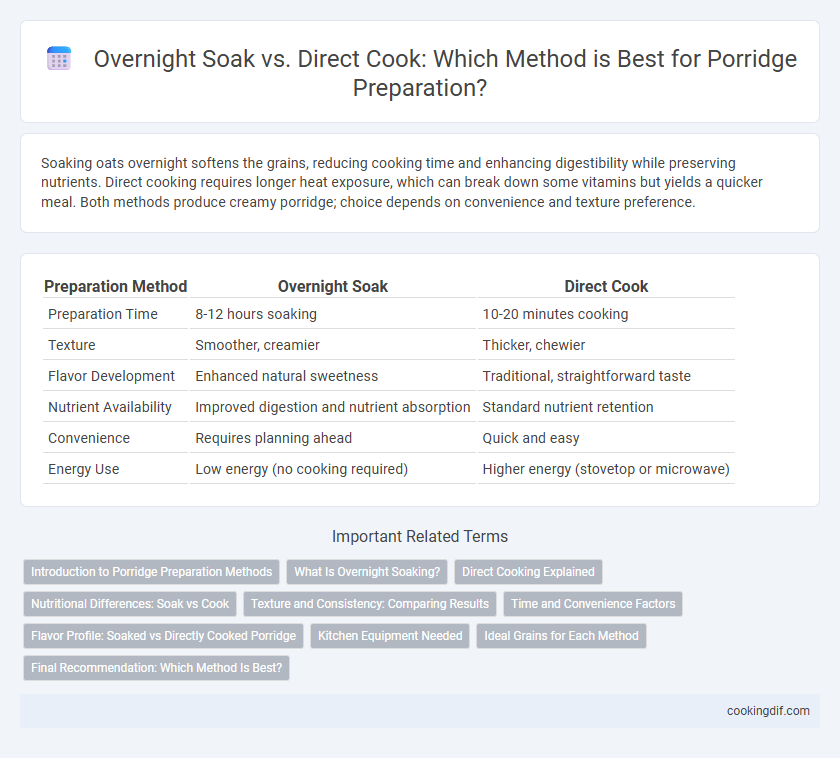Soaking oats overnight softens the grains, reducing cooking time and enhancing digestibility while preserving nutrients. Direct cooking requires longer heat exposure, which can break down some vitamins but yields a quicker meal. Both methods produce creamy porridge; choice depends on convenience and texture preference.
Table of Comparison
| Preparation Method | Overnight Soak | Direct Cook |
|---|---|---|
| Preparation Time | 8-12 hours soaking | 10-20 minutes cooking |
| Texture | Smoother, creamier | Thicker, chewier |
| Flavor Development | Enhanced natural sweetness | Traditional, straightforward taste |
| Nutrient Availability | Improved digestion and nutrient absorption | Standard nutrient retention |
| Convenience | Requires planning ahead | Quick and easy |
| Energy Use | Low energy (no cooking required) | Higher energy (stovetop or microwave) |
Introduction to Porridge Preparation Methods
Overnight soaking allows grains like oats or rice to absorb water, softening them and reducing cooking time while enhancing nutrient availability. Direct cooking involves boiling grains immediately, resulting in a quicker, warmer meal but often requires longer cooking times to achieve desired texture. Choosing between these methods depends on time availability and desired porridge consistency, with overnight soaking favored for convenience and improved digestion.
What Is Overnight Soaking?
Overnight soaking involves immersing grains or oats in water or milk for several hours before cooking, allowing them to absorb liquid and soften. This method reduces cooking time and enhances digestibility by breaking down starches and activating enzymes. Compared to direct cooking, overnight soaking results in creamier porridge with improved texture and nutritional availability.
Direct Cooking Explained
Direct cooking porridge involves combining grains like oats or rice with water or milk and heating the mixture immediately until it thickens to a creamy consistency. This method preserves the natural texture and flavor of the grains and reduces preparation time compared to overnight soaking. It is ideal for quick, nutritious meals without the need for advance planning.
Nutritional Differences: Soak vs Cook
Overnight soaking of porridge grains enhances nutrient absorption by partially breaking down phytic acid, increasing the bioavailability of minerals like iron and zinc compared to direct cooking. Direct cooking preserves water-soluble vitamins such as B-complex and vitamin C, which can degrade during prolonged soaking. Balancing soaking and cooking methods optimizes nutrient retention, delivering higher mineral uptake with intact vitamin content in the final porridge.
Texture and Consistency: Comparing Results
Overnight soaking allows oats to absorb water gradually, resulting in a creamier and softer porridge texture with a more uniform consistency. Direct cooking heats oats rapidly, often producing a thicker, chewier porridge with a slightly grainier mouthfeel. The choice between these methods significantly impacts the final porridge's smoothness and density, influencing personal preference for texture.
Time and Convenience Factors
Overnight soaking for porridge reduces active cooking time to just a few minutes in the morning, enhancing convenience for busy schedules while improving grain digestibility. Direct cooking requires 15-30 minutes of continuous stove time, which can be less suitable for rushed mornings but allows immediate preparation without prior planning. Choosing between methods depends on balancing available time with the desire for quick, hassle-free breakfast preparation.
Flavor Profile: Soaked vs Directly Cooked Porridge
Overnight soaking enhances porridge flavor by allowing grains to absorb water, leading to a creamier texture and deeper, nuttier taste due to natural enzyme activation. Direct cooking produces a more straightforward, slightly grainy flavor with less depth since grains have less time to hydrate and soften. The difference in preparation significantly impacts the porridge's mouthfeel and overall flavor complexity.
Kitchen Equipment Needed
Overnight soak porridge preparation requires minimal kitchen equipment, primarily a container for soaking oats and a refrigerator for the soaking process. Direct cook methods necessitate a stovetop or electric cooker, along with a pot or saucepan to heat and stir the porridge. Choosing between these methods depends on the available kitchen tools and time flexibility.
Ideal Grains for Each Method
Oats and steel-cut grains are ideal for overnight soaking due to their ability to absorb liquid and soften without breaking down, enhancing digestibility and reducing cooking time. Instant oats and quick-cooking grains suit direct cooking methods, as they require minimal preparation and soften rapidly under heat. Choosing the appropriate grain type for each method optimizes texture and nutritional value in porridge preparation.
Final Recommendation: Which Method Is Best?
Overnight soaking softens grains, reduces cooking time, and enhances nutrient absorption, making it a preferred method for porridge preparation. Direct cooking offers convenience and speed but may result in a less creamy texture and longer cooking duration. For optimal flavor, texture, and nutritional benefits, overnight soaking is generally the best choice for preparing porridge.
Overnight soak vs direct cook for porridge preparation Infographic

 cookingdif.com
cookingdif.com